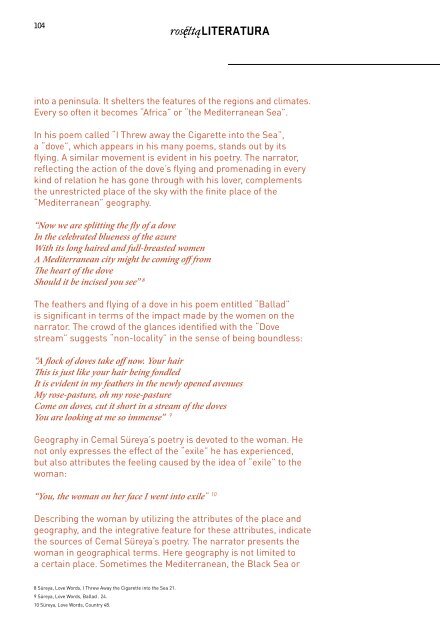ROSETTA_MAGAZINE_201303
ROSETTA_MAGAZINE_201303
ROSETTA_MAGAZINE_201303
You also want an ePaper? Increase the reach of your titles
YUMPU automatically turns print PDFs into web optimized ePapers that Google loves.
104<br />
into a peninsula. It shelters the features of the regions and climates.<br />
Every so often it becomes “Africa” or “the Mediterranean Sea”.<br />
In his poem called “I Threw away the Cigarette into the Sea”,<br />
a “dove”, which appears in his many poems, stands out by its<br />
flying. A similar movement is evident in his poetry. The narrator,<br />
reflecting the action of the dove’s flying and promenading in every<br />
kind of relation he has gone through with his lover, complements<br />
the unrestricted place of the sky with the finite place of the<br />
“Mediterranean” geography.<br />
“Now we are splitting the fly of a dove<br />
In the celebrated blueness of the azure<br />
With its long haired and full-breasted women<br />
A Mediterranean city might be coming off from<br />
The heart of the dove<br />
Should it be incised you see” 8<br />
The feathers and flying of a dove in his poem entitled “Ballad”<br />
is significant in terms of the impact made by the women on the<br />
narrator. The crowd of the glances identified with the “Dove<br />
stream” suggests “non-locality” in the sense of being boundless:<br />
“A flock of doves take off now. Your hair<br />
This is just like your hair being fondled<br />
It is evident in my feathers in the newly opened avenues<br />
My rose-pasture, oh my rose-pasture<br />
Come on doves, cut it short in a stream of the doves<br />
You are looking at me so immense” 9<br />
Geography in Cemal Süreya’s poetry is devoted to the woman. He<br />
not only expresses the effect of the “exile” he has experienced,<br />
but also attributes the feeling caused by the idea of “exile” to the<br />
woman:<br />
“You, the woman on her face I went into exile” 10<br />
Describing the woman by utilizing the attributes of the place and<br />
geography, and the integrative feature for these attributes, indicate<br />
the sources of Cemal Süreya’s poetry. The narrator presents the<br />
woman in geographical terms. Here geography is not limited to<br />
a certain place. Sometimes the Mediterranean, the Black Sea or<br />
8 Süreya, Love Words, I Threw Away the Cigarette into the Sea 21.<br />
9 Süreya, Love Words, Ballad . 24.<br />
10 Süreya, Love Words, Country 48.<br />
the mystical world of the East happen to be the destinations of the<br />
journey. The location concept being shaped in the fantasy space<br />
of the narrator is reflected on the woman’s body through external<br />
elements. The location being formed in the woman’s body is<br />
transformed into the language of poetry through the imagination<br />
of emotional motives. This striking feature is hidden in the style of<br />
the narrator.<br />
In the poem “Country” he sets out on a journey. Anatolia comes<br />
into focus via his quest for the woman. The narrator cites the<br />
samples he collected in the places he visited to the lover. Using<br />
expressions like “license to print money”, he makes historical<br />
references. By tapping into such sources he continually introduces<br />
such phrases as “an employee of a money mint factory,” and “Via<br />
the yellow of the ear of corn” in Konya; and in Antalya he looks for<br />
his woman through the clearness of the sea. From this aspect he<br />
transforms the one dimensional woman into a multi-dimensional<br />
identity.<br />
“And my aflutter heart floats in the stream of your hair<br />
It would have blended with the Black Sea and then the Mediterranean<br />
[…]<br />
An ear of corn would inform about Konya bit by bit<br />
I look for you in that ear of corn and Konya<br />
Nowadays I attribute everything to you, right?<br />
Gold scale, double measures and gold is worthless<br />
License to print money, water of the Euphrates, Palandöken<br />
The lowland of Erzincan, the bottom of hanging gardens<br />
Antalya’s sea and the bottom of that sea” 11<br />
In his poem “Unhappiness Smiling” the dynamic structure of his<br />
poetry collection entitled “Country” is maintained. The narrator,<br />
who does not like the silence and the stillness inside a stationary<br />
location, can only get over the negativity coming from being<br />
attached to a certain place by constantly relocating. He would<br />
not travel in confining locations. Since the multifarious locations<br />
would enhance the relationships of human to human and human<br />
to nature, they would leave a concrete impression on the subjects<br />
while at the same time building the structure of poetry:<br />
“Unhappiness comes in by smiling, and it is decorated with its name;<br />
11 Süreya, Love Words, Ülke 48.<br />
105


